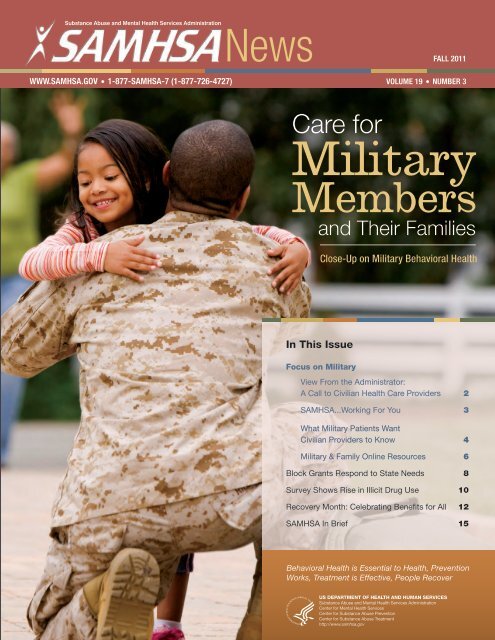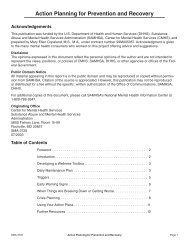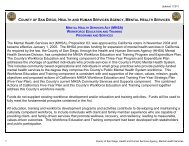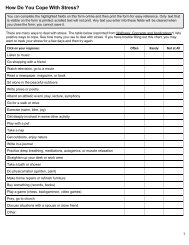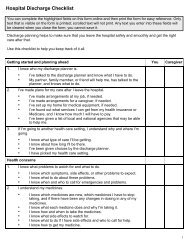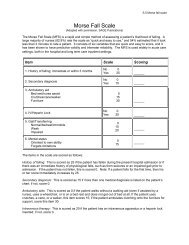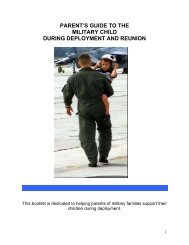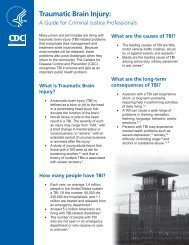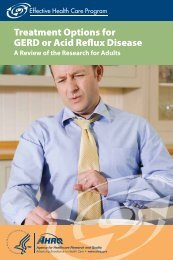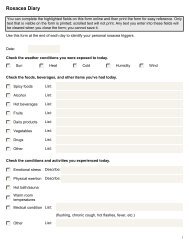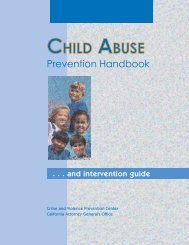Download PDF - Substance Abuse and Mental Health Services ...
Download PDF - Substance Abuse and Mental Health Services ...
Download PDF - Substance Abuse and Mental Health Services ...
You also want an ePaper? Increase the reach of your titles
YUMPU automatically turns print PDFs into web optimized ePapers that Google loves.
WWW.SAMHSA.GOV • 1-877-SAMHSA-7 (1-877-726-4727)<br />
News FALL<br />
2011<br />
VOLUME 19 • NUMBER 3<br />
Care for<br />
Military<br />
Members<br />
<strong>and</strong> Their Families<br />
Close-Up on Military Behavioral <strong>Health</strong><br />
In This Issue<br />
Focus on Military<br />
View From the Administrator:<br />
A Call to Civilian <strong>Health</strong> Care Providers 2<br />
SAMHSA...Working For You 3<br />
What Military Patients Want<br />
Civilian Providers to Know 4<br />
Military & Family Online Resources 6<br />
Block Grants Respond to State Needs 8<br />
Survey Shows Rise in Illicit Drug Use 10<br />
Recovery Month: Celebrating Benefits for All 12<br />
SAMHSA In Brief 15<br />
Behavioral <strong>Health</strong> is Essential to <strong>Health</strong>, Prevention<br />
Works, Treatment is Effective, People Recover<br />
US DEPARTMENT OF HEALTH AND HUMAN SERVICES<br />
<strong>Substance</strong> <strong>Abuse</strong> <strong>and</strong> <strong>Mental</strong> <strong>Health</strong> <strong>Services</strong> Administration<br />
Center for <strong>Mental</strong> <strong>Health</strong> <strong>Services</strong><br />
Center for <strong>Substance</strong> <strong>Abuse</strong> Prevention<br />
Center for <strong>Substance</strong> <strong>Abuse</strong> Treatment<br />
http://www.samhsa.gov<br />
www.samhsa.gov/samhsaNewsletter | 1
Pamela S. Hyde, J.D.<br />
View<br />
From the Administrator<br />
A Call to Civilian <strong>Health</strong> Care Providers<br />
In the 10 years since the<br />
September 11 attacks, more than<br />
2 million United States troops have<br />
been deployed to Iraq <strong>and</strong> Afghanistan.<br />
Although most of our returning<br />
service men <strong>and</strong> women successfully<br />
reintegrate into civilian life, many are<br />
unable to transition easily as a result<br />
of frequent deployments, separations<br />
from family, exposure to combat, <strong>and</strong><br />
sustained injuries. These military<br />
members may struggle with a traumatic<br />
brain injury (TBI), post-traumatic<br />
stress disorder (PTSD), depression,<br />
<strong>and</strong>/or substance use. And far too<br />
many, unable to cope, take their lives.<br />
To respond to the behavioral health<br />
needs of military members <strong>and</strong> their<br />
families, SAMHSA has been leading<br />
efforts to fulfill the goals of the<br />
Military Families Initiative, one of<br />
eight strategic initiatives introduced<br />
in Leading Change: A Plan for<br />
SAMHSA’s Roles <strong>and</strong> Actions 2011<br />
– 2014. Key to this initiative is<br />
improving military families’ access<br />
to high quality, trauma-informed care<br />
by service providers familiar with the<br />
culture of the military.<br />
Members of the military generally<br />
receive behavioral health care services<br />
through the Department of Defense<br />
(DoD) or the Department of Veterans<br />
Affairs (VA), but many also receive<br />
services from civilian health care<br />
providers. Because we know that<br />
private-sector providers can be more<br />
effective in treating military consumers<br />
if they underst<strong>and</strong> the military culture,<br />
combat experience, <strong>and</strong> challenges of<br />
deployment, SAMHSA encourages<br />
civilian mental health practitioners<br />
to become certified TRICARE<br />
providers. Credentialing information<br />
<strong>and</strong> details on participating in the<br />
TRICARE network are available<br />
through the SAMHSA Technical<br />
Assistance Packet for Becoming a<br />
TRICARE Provider.<br />
The well-being <strong>and</strong> psychological<br />
health of military families is an<br />
Nearly 600,000<br />
veterans aged 18 or<br />
older experienced a<br />
co-occurring substance<br />
use disorder <strong>and</strong> mental<br />
illness in the past<br />
12 months.<br />
2009 <strong>and</strong> 2010 National Survey<br />
on Drug Use <strong>and</strong> <strong>Health</strong>, SAMHSA.<br />
Administration priority <strong>and</strong> is the<br />
goal of the Presidential Initiative<br />
outlined in the report, Strengthening<br />
Our Military Families: Meeting<br />
America’s Commitment. We are<br />
pleased that the initiative is<br />
committed to working with the<br />
National Action Alliance for Suicide<br />
Prevention (NAASP), of which<br />
SAMHSA is a member, <strong>and</strong> to the<br />
Veterans Crisis Line, a product of<br />
our partnership with the VA <strong>and</strong> the<br />
National Suicide Prevention Lifeline.<br />
The report also stresses the need<br />
to reduce misleading, inaccurate<br />
depictions of veterans <strong>and</strong> military<br />
families with behavioral health<br />
problems in the media <strong>and</strong> recognizes<br />
SAMHSA’s 2010 Voice Awards<br />
program for excelling in this effort.<br />
The Veterans Crisis Line—available<br />
in the U.S. since 2007 <strong>and</strong> responsible<br />
for more than 17,000 emergency<br />
rescues of veterans at imminent risk<br />
of taking their lives—can now be<br />
accessed in Germany, Belgium,<br />
United Kingdom, Italy, <strong>and</strong> the<br />
Netherl<strong>and</strong>s by active-duty military,<br />
family members, <strong>and</strong> civilians. The<br />
Lifeline will soon be available in other<br />
European countries <strong>and</strong> parts of Asia.<br />
Military members anywhere with<br />
Internet access can chat online with<br />
qualified counselors.<br />
Because social connectedness is vital<br />
to an individual’s mental <strong>and</strong> emotional<br />
well-being, SAMHSA is pleased to be<br />
a part of the expansion of Partners in<br />
Care, a program to engage members<br />
of faith-based communities in creating<br />
a sense of community for National<br />
Guard members <strong>and</strong> their families.<br />
The program, originated by Chaplain<br />
(Colonel) Sean Lee of the Maryl<strong>and</strong><br />
National Guard, will be adopted by<br />
five other states under the auspices<br />
of the Military/Veterans Task Force of<br />
the NAASP. SAMHSA will distribute<br />
the Partners in Care materials that<br />
we develop to the National Guard to<br />
help other states as well.<br />
I urge you to read the other articles<br />
in this issue of SAMHSA News for<br />
valuable information <strong>and</strong> resources<br />
for military patients <strong>and</strong> their<br />
service providers. Together, we can<br />
serve members of our military as<br />
they have so steadfastly served us.•<br />
2 | SAMHSA News | FALL 2011
SAMHSA...Working For You<br />
For Military Members<br />
Voucher System to Broaden<br />
Provider Choice – A voucher<br />
system through SAMHSA’s Access to<br />
Recovery (ATR) discretionary grants<br />
program that exp<strong>and</strong>s military<br />
members’ access to substance abuse<br />
treatment <strong>and</strong> recovery services <strong>and</strong><br />
increases diversity of network<br />
providers. Currently, 14 states <strong>and</strong><br />
1 tribal organization participate in<br />
this system.<br />
http://www.atr.samhsa.gov/<br />
faq.aspx<br />
Team Readiness – A substance<br />
abuse prevention program for<br />
National Guard members that<br />
teaches effective communication<br />
skills. Through the program,<br />
participants learn how to recognize<br />
<strong>and</strong> address behavioral health issues<br />
in themselves <strong>and</strong> in their battle<br />
buddies <strong>and</strong> how to encourage their<br />
peers to get professional help. The<br />
National Guard found a model<br />
program through SAMHSA’s<br />
National Registry of Evidence-Based<br />
Programs <strong>and</strong> Practices <strong>and</strong> then<br />
worked to make the training relevant<br />
for military culture.<br />
http://www.samhsa.gov/<br />
SAMHSA_News/VolumeXVI_4/<br />
article8.htm<br />
For States <strong>and</strong> Territories<br />
Focused on Helping Service<br />
Members<br />
of military servicemembers, veterans Defense, VA, the Vet Centers, <strong>and</strong><br />
<strong>and</strong> their families. To date, 16 states the <strong>Health</strong> Resources <strong>and</strong> <strong>Services</strong><br />
<strong>and</strong> 2 territories have participated, Administration.<br />
<strong>and</strong> other states plan to follow suit by http://www.mdva.state.md.us/<br />
the end of 2011. (See SAMHSA News,<br />
July/August 2010 http://www. Operation Immersion (OI) –<br />
samhsa.gov/samhsanewsletter/ A two-day experiential training where<br />
Volume_18_Number_4/behavioral participants are immersed in the<br />
<strong>Health</strong>ServiceMembers.aspx.) military lifestyle. Since its launch in<br />
2010, 500 private sector mental<br />
For Providers<br />
health professionals (recipients of<br />
Building Bridges to Support SAMHSA ATR discretionary grants)<br />
Military <strong>and</strong> Veteran Families: have graduated from the training.<br />
<strong>Health</strong>care Providers Resource (See SAMHSA News, September/<br />
Guide – A quick reference of<br />
October 2010 http://www.samhsa.<br />
relevant resources for the provider gov/SAMHSAnewsLetter/<br />
working with servicemembers,<br />
Volume_18_Number_5/Military<br />
veterans, <strong>and</strong> families to maintain ImmersionTraining.aspx).<br />
their health <strong>and</strong> positive family<br />
functioning. The guide was developed<br />
by SAMHSA, the Department of<br />
Online Resources From the Administrator’s View<br />
Partners in Care<br />
Strengthening Our Military<br />
http://actionallianceforsuicide Families: Meeting America’s<br />
prevention.org/wp-content/<br />
Commitment<br />
themes/twentyten/images/pdfs/ http://www.whitehouse.gov/<br />
taskforces/MilitaryVeterans.pdf sites/default/files/rss_viewer/<br />
strengthening_our_military_<br />
SAMHSA Technical Assistance families_meeting_americas_<br />
Packet for Becoming a<br />
commitment_january_2011.pdf<br />
TRICARE Provider<br />
http://www.thenationalcouncil.org/ TRICARE Provider<br />
cs/resources_services/becoming_ http://www.tricare.mil/providers<br />
a_tricare_provider#ta_packet<br />
Returning Service Members,<br />
Veterans, <strong>and</strong> Families’ Policy<br />
Academies – The program assists<br />
states in creating comprehensive<br />
statewide plans to address the<br />
culturally distinct behavioral needs<br />
For a list of online <strong>and</strong> in-person<br />
trainings <strong>and</strong> courses, visit:<br />
http://www.thenationalcouncil.<br />
org/cs/curriculum_<strong>and</strong>_courses<br />
The Veterans’ Crisis Line<br />
http://veteranscrisisline.net/<br />
ChatTermsOfService.aspx?<br />
account=Veterans%20Chat<br />
www.samhsa.gov/samhsaNewsletter | 3
Captain Ross Maher speaking to a group of health<br />
care providers with Operation Immersion.<br />
Photo courtesy of Army Sergeant Peter Ramaglia<br />
What Military Patients<br />
Want Civilian Providers to Know<br />
By S<strong>and</strong>y D. Cogan<br />
“My memories are full of jargon,” Senior Master Sgt Leonard Macari says.<br />
“If I finally open up to a counselor, I don’t want to have to stop <strong>and</strong> explain<br />
acronyms like MRE or terms like ‘I did a 5 <strong>and</strong> 25.’ I want my therapist to<br />
know what I’m talking about. Otherwise, there’s a disconnect that’s hard<br />
to get past,” the Rhode Isl<strong>and</strong> National Guardsman explains.<br />
4 | SAMHSA News | FALL 2011
Other servicemembers agree<br />
that civilian providers, while professionally<br />
competent, often lack an underst<strong>and</strong>ing<br />
of the warrior’s way of life as well as<br />
their experiences, challenges <strong>and</strong> language.<br />
That lack of knowledge <strong>and</strong> appreciation<br />
is often the reason military patients<br />
discontinue treatment with a communitybased<br />
behavioral health service provider<br />
after only one visit, say experts.<br />
Fear of Repercussions<br />
“Some of our military personnel who<br />
are suffering from post-traumatic<br />
stress disorder, major depression,<br />
a traumatic brain injury, <strong>and</strong>/or<br />
substance abuse are choosing<br />
private-sector providers<br />
over military therapists for<br />
fear of discrimination or<br />
jeopardizing their career or<br />
their spouse’s career,” says<br />
A. Kathryn Power, M.Ed.,<br />
Director of the Center for<br />
<strong>Mental</strong> <strong>Health</strong> <strong>Services</strong><br />
(CMHS) at SAMHSA <strong>and</strong><br />
lead for the Agency’s<br />
Military Families Strategic<br />
Initiative. “Finding a<br />
community-based provider<br />
who underst<strong>and</strong>s the<br />
military culture <strong>and</strong><br />
language is hit or miss; <strong>and</strong><br />
that underst<strong>and</strong>ing<br />
can be the difference between<br />
receiving ongoing, effective<br />
treatment <strong>and</strong> not returning<br />
for a second appointment.”<br />
An active duty service member, who<br />
asked to remain anonymous, concurs.<br />
After months of heavy drinking <strong>and</strong><br />
misuse of prescription drugs, he<br />
turned to a community-based provider<br />
for help because he didn’t want to risk<br />
being “kicked out of the Army after<br />
20 years of service.” He recounts that<br />
while sharing his combat experiences<br />
about how he lost both legs <strong>and</strong> came<br />
home to find his wife <strong>and</strong> kids gone,<br />
“the therapist started crying. On top<br />
of that, he kept interrupting me,<br />
asking what I mean by this term <strong>and</strong><br />
that.” The sergeant shakes his head.<br />
“I never went back to him, <strong>and</strong> I never<br />
went to another civilian provider, <strong>and</strong><br />
yes, I’m still using.”<br />
SAMHSA’s Role<br />
Ms. Power emphasizes that “most<br />
servicemembers have strong resiliency<br />
that enables them to deal successfully<br />
with isolation, multiple relocations,<br />
<strong>and</strong> new environments, in addition to<br />
combat-related stressors <strong>and</strong> trauma.<br />
For those who do not, it is our responsibility<br />
<strong>and</strong> our duty to help them<br />
heal <strong>and</strong> re-integrate into society.”<br />
SAMHSA works in partnership with<br />
More than 1.6 million U.S. veterans meet<br />
the criteria for a substance use disorder.<br />
More than 1 million veterans had<br />
experienced a major depressive episode<br />
within the past 12 months during 2009<br />
<strong>and</strong> 2010.<br />
2009 <strong>and</strong> 2010 National Survey on Drug Use <strong>and</strong><br />
<strong>Health</strong>, SAMHSA.<br />
the Department of Veterans Affairs<br />
<strong>and</strong> the Department of Defense in<br />
providing information <strong>and</strong> assistance,<br />
<strong>and</strong> by enhancing the underst<strong>and</strong>ing<br />
of behavioral health service providers<br />
in the civilian community. In support<br />
of this effort, SAMHSA has introduced<br />
the Military Families’ Strategic<br />
Initiative as part of Leading Change:<br />
A Plan for SAMHSA’s Roles <strong>and</strong> Actions<br />
2011-2014 (http://store.samhsa.gov/<br />
product/SMA11-4629). In addition, the<br />
National Action Alliance for Suicide<br />
Prevention, of which SAMHSA is a<br />
member, established the Military/<br />
Veterans Task Force (http://www.<br />
actionallianceforsuicideprevention.<br />
org) to strengthen suicide prevention<br />
efforts among this high-risk population.<br />
Lessons in the Warrior Culture<br />
Insight into the military culture is<br />
often just a click away. (See Resources,<br />
p. 6.) For example, civilian providers<br />
can learn about the warrior culture,<br />
the issues around deployment <strong>and</strong> the<br />
stress <strong>and</strong> trauma of combat through<br />
online webinars, speaker series, <strong>and</strong><br />
online interactive courses–both for<br />
credit <strong>and</strong> non-credit. Private-sector<br />
therapists can also participate in<br />
in-person trainings held year round<br />
across the country.<br />
Lisa Peterson, LMHC,<br />
LCDP, a civilian treatment<br />
provider, recently participated<br />
in one such training—<br />
Operation Immersion (OI),<br />
a two-day experiential<br />
program in which civilian<br />
therapists were plunged<br />
into the military way of life.<br />
The experience, she says,<br />
has won her “credibility”<br />
among her military clients.<br />
It also created a noticeable<br />
shift in the client-therapist<br />
dynamics in the psychoeducational<br />
classes she<br />
manages for veterans<br />
suffering trauma, addictions,<br />
<strong>and</strong> mental health issues at a<br />
community behavioral health care<br />
center in Warwick, RI.<br />
“Before I went through OI—where<br />
we slept in bunk beds in open bays,<br />
shared showers, ate MREs (Meals,<br />
Ready-to-Eat), <strong>and</strong> pushed through<br />
a high cardio workout—some of my<br />
military clients were guarded <strong>and</strong><br />
unsure if I would underst<strong>and</strong> their<br />
issues or experiences,” Ms. Peterson<br />
says. “When they saw a MRE on<br />
my desk, they began sharing their<br />
personal stories more spontaneously<br />
www.samhsa.gov/samhsaNewsletter | 5
with me <strong>and</strong> expressed appreciation<br />
for my efforts to learn their culture.”<br />
Jill Legault, LCDP, a community-based<br />
substance abuse counselor, says that her<br />
military patients are more “forthcoming”<br />
now that she has participated in OI.<br />
“Before learning about the military<br />
culture, I couldn’t fully appreciate my<br />
military clients’ problems. I didn’t<br />
underst<strong>and</strong> words like ‘convoy’ or<br />
acronyms like ‘IED.’” Now Ms. Legault<br />
says she has a new appreciation of their<br />
experiences <strong>and</strong> is changing the goals<br />
of treatment to be more family-centric.<br />
Another civilian therapist, who asked<br />
not to be named, said she used to be<br />
“intimidated by servicemembers who<br />
would ask her how she could help if<br />
she had never been where they had<br />
been.” After having taken several<br />
online courses about the military<br />
culture <strong>and</strong> experience, she feels<br />
more confident asking her military<br />
patients questions about their<br />
experiences, questions that helped<br />
build rapport, such as “How many<br />
times have you been deployed?” or<br />
“Where <strong>and</strong> when were you deployed?”<br />
This, she says, shows she underst<strong>and</strong>s<br />
that different places at different<br />
times have different stressors.<br />
Military & Family Online Resources<br />
<strong>Substance</strong> <strong>Abuse</strong> <strong>and</strong> <strong>Mental</strong> <strong>Health</strong><br />
<strong>Services</strong> Administration<br />
(SAMHSA)<br />
http://www.samhsa.gov<br />
SAMHSA Military Families<br />
Strategic Initiative<br />
http://www.samhsa.gov/<br />
militaryfamilies<br />
Veterans Crisis Line in U.S.<br />
<strong>and</strong> Europe<br />
Offers a confidential toll-free crisis line<br />
<strong>and</strong> online chat for veterans <strong>and</strong> their loved<br />
ones: http://www.veteranscrisisline.<br />
net or 1-800-273-8255, press 1 to chat<br />
online. In Germany, Belgium, United<br />
Kingdom, Italy, <strong>and</strong> the Netherl<strong>and</strong>s<br />
call: 00-800-1273-8255. Individuals on<br />
military bases can access the Lifeline<br />
with a 3-digit access code (118)<br />
through their DSN system.<br />
Center for Deployment<br />
Psychology<br />
Provides military culture <strong>and</strong> other<br />
behavioral health training <strong>and</strong> offers<br />
online courses:<br />
http://deploymentpsych.org<br />
afterdeployment.org<br />
Features videos of servicemembers<br />
who have found value in seeking<br />
mental health support <strong>and</strong> treatment:<br />
http://afterdeployment.org<br />
RealWarriors.net<br />
Provides an interactive site focused<br />
on reducing stigma associated with<br />
seeking help; includes video profiles<br />
of servicemembers <strong>and</strong> their<br />
families <strong>and</strong> resources:<br />
http://www.realwarriors.net<br />
National Child Traumatic<br />
Stress Network<br />
Offers a Masters’ Speakers series <strong>and</strong><br />
other podcasts for providers on physical,<br />
psychological, <strong>and</strong> moral stressors of<br />
combat <strong>and</strong> how trauma-related<br />
stresses affect spouses <strong>and</strong> children:<br />
http://learn.nctsn.org<br />
The National Council for<br />
Community <strong>and</strong> Behavior <strong>Health</strong><br />
Promotes <strong>Mental</strong> <strong>Health</strong> First Aid for<br />
Veterans <strong>and</strong> Serving Our Veterans<br />
Behavioral <strong>Health</strong> Certificate:<br />
http://www.thenationalcouncil.<br />
org/cs/veterans; <strong>and</strong> continuing<br />
education hours: http://www.<br />
thenationalcouncil.org<br />
Resource Center to Promote<br />
Acceptance, Dignity <strong>and</strong> Social<br />
Inclusion Associated with<br />
<strong>Mental</strong> <strong>Health</strong><br />
Contains archived teleconference<br />
trainings to support mental health<br />
for military families:<br />
http://promoteacceptance.<br />
samhsa.gov<br />
Campaign for Social Inclusion<br />
Promotes acceptance <strong>and</strong> social inclusion:<br />
http://www.stopstigma.samhsa.gov/<br />
CSI/default.aspx<br />
inTransition<br />
Offers mental health coaching <strong>and</strong><br />
support program for active duty,<br />
guard <strong>and</strong> reserve servicemembers<br />
who are receiving mental health care<br />
<strong>and</strong> experiencing a transition:<br />
http://www.health.mil/intransition<br />
Sesame Street – Talk, Listen, Connect<br />
Includes information, resources,<br />
activities <strong>and</strong> support for families<br />
coping with deployment, homecomings,<br />
changes, <strong>and</strong> grief:<br />
http://www.sesameworkshop.org/<br />
initiatives/emotion/tlc<br />
Defense Centers of Excellence<br />
for Psychological <strong>Health</strong> <strong>and</strong><br />
Traumatic Brain Injury<br />
Includes information on best<br />
practices <strong>and</strong> quality st<strong>and</strong>ards for<br />
promoting the resilience, recovery<br />
<strong>and</strong> reintegration of warriors <strong>and</strong><br />
their families:<br />
http://www.dcoe.health.mil<br />
Military OneSource<br />
Offers resources for servicemembers<br />
<strong>and</strong> their families; information <strong>and</strong><br />
materials for providers:<br />
http://www.militaryonesource.com/<br />
MOS.aspx<br />
Supportive <strong>Services</strong> for Veteran<br />
Families (SSVF) Program<br />
Offers VA grants to organizations to<br />
provide housing stability support to<br />
eligible, low income veteran families:<br />
http://www.va.gov/homeless/ssvf.asp<br />
6 | SAMHSA News | FALL 2011
Military Members Access to Care<br />
Master Sergeant (MSG) Stephanie Weaver,<br />
liaison to SAMHSA from the National Guard<br />
Bureau, emphasizes that military culture <strong>and</strong><br />
treatment implications vary among the various<br />
branches of the service as well as the National<br />
Guard <strong>and</strong> the Reserves.<br />
“Most members of the military <strong>and</strong> their<br />
families are covered by TRICARE,” she says,<br />
“which covers behavioral health care provided on<br />
military bases <strong>and</strong> also sometimes among<br />
private providers who get TRICARE certification.<br />
But the status of National Guard <strong>and</strong><br />
Reservists as ‘citizen soldiers’ means that their<br />
health care benefits differ from those of other<br />
soldiers. Many of those deployed to Iraq or<br />
Afghanistan find their benefits for substance<br />
abuse <strong>and</strong> mental health services are very<br />
limited upon their return. Most of them receive<br />
these services from community providers.<br />
“It’s important that needs of the National<br />
Guard <strong>and</strong> Reservists be understood <strong>and</strong><br />
addressed,” says MSG Weaver. (For more<br />
information on SAMHSA’s work with the<br />
National Guard, see SAMHSA News, September/<br />
October 2010, http://www.samhsa.gov/<br />
SAMHSAnewsLetter/Volume_18_Number_<br />
5/default.aspx.)<br />
How Community-Based Providers<br />
Can Serve<br />
Ms. Power encourages private-sector providers to<br />
become TRICARE-authorized (certified) practitioners<br />
(http://www.tricare.mil/providers) to<br />
ensure they are eligible for reimbursement for their<br />
services to military members <strong>and</strong> their families.<br />
She adds, “We encourage private-sector mental<br />
health professionals to serve our men <strong>and</strong> women<br />
in uniform. Their help can ensure our military<br />
consumers continue treatment <strong>and</strong> therapy <strong>and</strong><br />
have a greater opportunity to recover. Supporting<br />
<strong>and</strong> strengthening our military families is not<br />
only critical to our national security, it is a national<br />
moral obligation.”•<br />
For more information on SAMHSA’s Military<br />
Families’ Strategic Initiative, visit http://<br />
www.samhsa.gov/MilitaryFamilies.<br />
Staff Sergeant David Hollinrake (left) instructs<br />
trainee Lel<strong>and</strong> Wilcox about the military way of<br />
life during Operation Immersion in Warwick, RI.<br />
www.samhsa.gov/samhsaNewsletter Photo courtesy of Army Sergeant Peter | 7Ramaglia
Block Grants<br />
Respond to State Needs<br />
By 2014, 32 million more<br />
people will be eligible for health coverage<br />
through the Affordable Care Act,<br />
spelling big changes for the behavioral<br />
health field. Qualified providers will be<br />
in greater dem<strong>and</strong>, while state budgets<br />
remain tight <strong>and</strong> decisionmakers will be<br />
pressed to allocate resources toward the<br />
most successful substance abuse <strong>and</strong><br />
mental health services.<br />
In this environment, SAMHSA’s block<br />
grant program is providing a lifeline to<br />
states that are already planning ahead<br />
for this new reality. Recent changes to<br />
the applications for SAMHSA’s <strong>Substance</strong><br />
<strong>Abuse</strong> Prevention <strong>and</strong> Treatment<br />
Block Grant (SABG) <strong>and</strong> Community<br />
<strong>Mental</strong> <strong>Health</strong> <strong>Services</strong> Block Grant<br />
(MHBG) were rolled out earlier this<br />
year to address emerging needs.<br />
SAMHSA will provide nearly<br />
$1.9 billion in FY2012 to help<br />
states address behavioral health<br />
problems through its block grants.<br />
These changes reflect the need to<br />
exp<strong>and</strong> the block grants’ reach to focus<br />
more heavily on low-income populations<br />
<strong>and</strong> the uninsured, including people<br />
<strong>and</strong> services not covered by health<br />
reform. They also streamline the<br />
application process so that states whose<br />
mental health <strong>and</strong> substance abuse<br />
offices overlap do not have to complete<br />
separate application forms. The new<br />
application process focuses on<br />
ensuring the sustainability of these<br />
successful behavioral health care<br />
programs, while ensuring that the<br />
needs of states are met by providing a<br />
flexible, biannual application system.<br />
The block grants are designed to<br />
provide a safety net for people who do<br />
not have health insurance—even for<br />
short periods of time—by funding<br />
priority prevention, treatment, <strong>and</strong><br />
recovery support services specifically for<br />
those in need. They focus on services<br />
that will not be covered by Medicaid,<br />
Medicare, or private insurance through<br />
health exchanges. Future funds can<br />
be used for broader prevention <strong>and</strong><br />
recovery support services as needs<br />
evolve. The new block grants are also<br />
designed to provide a reliable source<br />
of funding for primary substance<br />
abuse prevention activities.<br />
“Changes in health care<br />
delivery structures, rapid<br />
adoption of health information<br />
technology, scientific advances<br />
in prevention <strong>and</strong> treatment<br />
services, growing underst<strong>and</strong>ing<br />
of recovery, <strong>and</strong> implementation<br />
of the <strong>Mental</strong> <strong>Health</strong><br />
Parity <strong>and</strong> Addiction Equity<br />
Act <strong>and</strong> the Affordable Care<br />
Act will greatly enhance access to<br />
prevention, treatment, <strong>and</strong> recovery<br />
support services nationwide,” said<br />
SAMHSA Administrator Pamela S.<br />
Hyde, J.D. “These changes also<br />
present opportunities to establish the<br />
role of the block grants as critical<br />
underpinnings of the public substance<br />
abuse <strong>and</strong> mental health service<br />
systems, drivers of quality <strong>and</strong><br />
innovation, <strong>and</strong> essential resources for<br />
transforming health care in America,<br />
especially in difficult economic times.”<br />
Community Assistance<br />
In all, SAMHSA will provide nearly<br />
$1.9 billion in FY2012 to help states<br />
address behavioral health problems<br />
through its block grants. These<br />
significant resources are designed to<br />
give states the flexibility to design<br />
<strong>and</strong> implement behavioral health<br />
programs <strong>and</strong> fund targeted prevention<br />
activities that meet the needs of their<br />
communities. In alignment with the<br />
National Prevention Strategy, the<br />
new block grants are designed to<br />
foster healthier, safer community<br />
environments; ensure the availability<br />
of community preventive services;<br />
empower individuals to make healthy<br />
choices; <strong>and</strong> eliminate health disparities.<br />
The grants support best practices by<br />
going toward proven services that have<br />
demonstrated success in improving<br />
outcomes or supporting recovery. In<br />
addition to funding treatment <strong>and</strong><br />
support services, they support a<br />
range of prevention efforts <strong>and</strong> help<br />
states collect outcomes <strong>and</strong> performance<br />
data to determine which<br />
prevention, treatment, <strong>and</strong> recovery<br />
support services are most effective.<br />
Implementing smart strategies for<br />
making the most of such vital behavioral<br />
health services is more important than<br />
ever, according to Administrator Hyde,<br />
particularly in this time of budget<br />
cutbacks. Reforming the block grants<br />
now to better empower states positions<br />
these resources as a critical<br />
component of our future health system.<br />
8 | SAMHSA News | FALL 2011
assessment <strong>and</strong> developing a plan to<br />
identify <strong>and</strong> analyze the strengths,<br />
needs, <strong>and</strong> priorities of their behavioral<br />
health systems. It also encouraged<br />
states to form strategic partnerships,<br />
develop collaborative plans for health<br />
information systems, increase their<br />
focus on recovery services, describe<br />
their work in consulting with tribal<br />
communities, <strong>and</strong> focus their block<br />
grant programs on improving<br />
accountability for the quality <strong>and</strong><br />
performance of services they provide.<br />
President Barack Obama, next to then 11-year-old<br />
Marcelas Owens (left), signs the Affordable <strong>Health</strong>Care<br />
Act, helping millions of Americans afford health care.<br />
“No state is free from the unique<br />
impact of mental <strong>and</strong> substance use<br />
disorders,” Administrator Hyde pointed<br />
out. For this reason, she noted that<br />
“data like these give states the<br />
information they can use to target<br />
their prevention <strong>and</strong> treatment<br />
activities for the greatest benefit<br />
to their residents.”<br />
Streamlined Application<br />
Until this year, states have had different<br />
structures for applying, accepting,<br />
planning, <strong>and</strong> accounting for the two<br />
block grants in their budgets. With<br />
SAMHSA’s new streamlined application,<br />
which was issued in July following a<br />
public comment period, states <strong>and</strong><br />
territories had the option to submit<br />
one coordinated plan for both block<br />
grants—covering both mental health<br />
<strong>and</strong> substance abuse services—by<br />
September 1, 2011. Alternatively,<br />
applicants could submit separate<br />
applications if preferred, with the final<br />
application for the SABG due by<br />
October 1, 2011, <strong>and</strong> the final application<br />
for the MHBG due by September 1, 2011.<br />
A total of 22 states <strong>and</strong> 2 territories<br />
took advantage of the opportunity to<br />
submit a combined application.<br />
For the first time, this year’s application<br />
enabled states <strong>and</strong> territories to apply<br />
for two-year grants (FY2012 <strong>and</strong><br />
FY2013), eliminating the need to<br />
submit a new application each year.<br />
The new application process was<br />
largely well received during the public<br />
comment period, with more than 770<br />
comments from 522 individuals <strong>and</strong><br />
organizations.<br />
Increased Planning <strong>and</strong><br />
Performance Evaluation<br />
The redesigned block grant application<br />
helped states explore how to adapt<br />
their behavioral health systems to<br />
best meet their needs over the next<br />
few years. The types <strong>and</strong> levels of<br />
behavioral health problems that states<br />
confront vary widely, according to<br />
SAMHSA’s report, State Estimates of<br />
<strong>Substance</strong> Use <strong>and</strong> <strong>Mental</strong> Disorders<br />
from the 2008-2009 National Survey<br />
on Drug Use <strong>and</strong> <strong>Health</strong>. These<br />
differences mean it’s critical for<br />
states to prioritize their needs to<br />
ensure that block grant funds are<br />
used where they are most needed.<br />
To assist states in their planning, the<br />
block grant application included<br />
guidance on conducting a needs<br />
Just as important as the planning phase<br />
is determining the results of federally<br />
funded programs <strong>and</strong> their outcomes<br />
in reducing the impact of substance<br />
abuse <strong>and</strong> mental illness on America’s<br />
communities. SAMHSA’s new grant<br />
process places a heavier emphasis on<br />
performance evaluation <strong>and</strong> monitoring,<br />
setting dashboard measures for<br />
grantees to show the effects of their<br />
programs. This focus on evaluation<br />
aligns with SAMHSA’s Strategic Initiative<br />
7—Data, Outcomes, <strong>and</strong> Quality—which<br />
strives to realize an integrated data<br />
strategy <strong>and</strong> national framework for<br />
quality improvement in behavioral<br />
health care. This framework will inform<br />
policy, measure program impact, <strong>and</strong><br />
lead to improved quality of services <strong>and</strong><br />
outcomes for individuals, families, <strong>and</strong><br />
communities.• By Kristin Engdahl<br />
Applications for FY2014-FY2015 block<br />
grants will be due April 1, 2013. For<br />
more information, visit http://samhsa.<br />
gov/grants/blockgrant.<br />
www.samhsa.gov/samhsaNewsletter | 9
National Survey Shows Rise in<br />
Illicit Drug Use<br />
Rates of Marijuana Use Drive Increase<br />
The use of illicit drugs<br />
among Americans increased between<br />
2008 <strong>and</strong> 2010 according to SAMHSA’s<br />
National Survey on Drug Use <strong>and</strong> <strong>Health</strong><br />
(NSDUH). According to the annual<br />
survey, 22.6 million Americans 12 <strong>and</strong><br />
older (8.9 percent of the population)<br />
were current illicit drug users. The<br />
rate of use in 2010 was similar to the rate<br />
in 2009 (8.7 percent), but remained<br />
above the 2008 rate (8 percent).<br />
An increased rate in the current use<br />
of marijuana seems to be one of the<br />
prime factors in the overall rise in<br />
illicit drug use. In 2010, 17.4 million<br />
Americans were current users of<br />
marijuana, compared to 14.4 million<br />
in 2007. This represents an increase<br />
in the rate of current marijuana use<br />
in the population 12 <strong>and</strong> older from 5.8<br />
percent in 2007 to 6.9 percent in 2010.<br />
“We st<strong>and</strong> at a crossroads in our<br />
Nation’s efforts to prevent substance<br />
abuse <strong>and</strong> addiction,” said SAMHSA<br />
Administrator Pamela S. Hyde, J.D.<br />
“These statistics represent real lives<br />
that are at risk from the harmful <strong>and</strong><br />
sometimes devastating effects of<br />
illicit drug use. This Nation cannot<br />
afford to risk losing more individuals,<br />
families, <strong>and</strong> communities to illicit<br />
drugs or from other types of<br />
substance abuse—instead, we must<br />
do everything we can to effectively<br />
promote prevention, treatment, <strong>and</strong><br />
recovery programs across our country.”<br />
Among the survey’s other noteworthy<br />
findings is that the majority (55<br />
percent) of persons aged 12 <strong>and</strong><br />
older who had used prescription pain<br />
relievers nonmedically in the past 12<br />
months received them from a friend<br />
or relative for free. Only 4.4 percent<br />
of those misusing pain relievers in<br />
the past year reported getting their<br />
supply from a drug dealer <strong>and</strong> 0.4<br />
percent bought it on the Internet.<br />
Despite some troubling trends,<br />
the 2010 NSDUH showed areas of<br />
improvement in terms of lower use<br />
levels for certain substances. The<br />
number of current methamphetamine<br />
users decreased by roughly half from<br />
2006 to 2010—from 731,000 people<br />
age 12 <strong>and</strong> older (0.3 percent) to<br />
353,000 (0.1 percent). Cocaine use<br />
has also declined, from 2.4 million<br />
Another disturbing trend is the<br />
continuing rise in the rate of current<br />
illicit drug use among young adults<br />
aged 18 to 25—from 19.6 percent in<br />
2008 to 21.2 percent in 2009 <strong>and</strong> 21.5<br />
percent in 2010. This increase was<br />
also driven in large part by a rise in<br />
the rate of current marijuana use<br />
among this population.<br />
The survey, released by SAMHSA<br />
at the kickoff of the 22nd annual<br />
National Recovery Month observance,<br />
also shows that use rates for nonmedical<br />
use of prescription drugs, hallucinogens<br />
<strong>and</strong> inhalants have remained at<br />
approximately the same levels as 2009,<br />
<strong>and</strong> are also similar to rates in 2002.<br />
Dr. H. Westley Clark presenting the NSDUH findings at<br />
the annual Recovery Month Press Conference.<br />
10 | SAMHSA News | FALL 2011
current users in 2006 to 1.5 million<br />
in 2010. In addition, among 12- to<br />
17-year-olds there were decreases<br />
between 2009 <strong>and</strong> 2010 in current<br />
drinking rates (from 14.7 percent<br />
to 13.6 percent) <strong>and</strong> current tobacco<br />
use rates (from 11.6 percent to<br />
10.7 percent). As in previous years,<br />
the 2010 NSDUH shows a vast<br />
disparity between the number<br />
of people needing specialized<br />
treatment for a substance abuse<br />
problem <strong>and</strong> the number who actually<br />
receive it. According to the survey,<br />
23.1 million Americans aged 12 <strong>and</strong><br />
older (9.1 percent) needed specialized<br />
treatment for a substance abuse<br />
problem, but only 2.6 million (or<br />
roughly 11.2 percent of them)<br />
received it.•<br />
Results from the 2010 National<br />
Survey on Drug Use <strong>and</strong> <strong>Health</strong>:<br />
Summary of National Findings are<br />
available on the SAMHSA Web site at<br />
http://oas.samhsa.gov/NSDUH/<br />
2k10NSDUH/2k10Results.htm.<br />
Source Where<br />
Pain Relievers<br />
Were Obtained<br />
for Most Recent<br />
Nonmedical Use<br />
Among Past Year<br />
Users Aged 12 or Older:<br />
2009-2010<br />
From Friend or<br />
Relative for Free<br />
55%<br />
Bought from<br />
Friend or<br />
Relative<br />
11.4%<br />
From Single<br />
Doctor<br />
17.3%<br />
Took from Friend or Relative<br />
Without Asking 4.8%<br />
Bought from Drug Dealer<br />
or Other Stranger 4.4%<br />
Bought on the Internet 0.4%<br />
Some Other Way 4.2%<br />
From Multiple Doctors 2.1%<br />
Wrote Fake Prescription 0.2%<br />
Stole from Doctor’s Office, Clinic,<br />
Hospital, or Pharmacy 0.2%<br />
Past Month<br />
Use of Selected<br />
Illicit Drugs<br />
Among Persons<br />
Aged 12 or Older:<br />
2002-2010<br />
2010 National Survey on Drug Use <strong>and</strong> <strong>Health</strong>, SAMHSA<br />
www.samhsa.gov/samhsaNewsletter | 11
Recovery Month<br />
Celebrating Benefits for All<br />
During September’s<br />
National Recovery Month, celebrations<br />
came in all sizes, shapes, <strong>and</strong> styles.<br />
Some types of events were rallies,<br />
rambles, jamborees, <strong>and</strong> paloozas;<br />
others were walks, runs, rides, concerts,<br />
<strong>and</strong> expos. While the events varied in<br />
creativity, they embraced a similar<br />
goal: building support for recovery from<br />
mental <strong>and</strong> substance use disorders.<br />
For the 22nd consecutive year, Recovery<br />
Month, sponsored by SAMHSA’s<br />
Center for <strong>Substance</strong> <strong>Abuse</strong><br />
Treatment, recognized people in<br />
recovery <strong>and</strong> lauded the work of<br />
treatment providers. In addition,<br />
SAMHSA released the results from<br />
the 2010 National Survey on<br />
Drug Use <strong>and</strong> <strong>Health</strong> at a press<br />
conference of the observance.<br />
(See SAMHSA News, p. 10.)<br />
“Recovery Month events attract<br />
millions of people each year,<br />
helping to educate the public <strong>and</strong><br />
policymakers about the reality of<br />
recovery,” said Pat Taylor,<br />
Executive Director of Faces &<br />
Voices of Recovery, a Recovery Month<br />
planning partner organization.<br />
“Events small <strong>and</strong> large bring<br />
together people in recovery, family<br />
members, friends, <strong>and</strong> allies<br />
in community spaces <strong>and</strong> build<br />
opportunities for sustained advocacy<br />
on behalf of recovery.”<br />
Recovery Month’s network of 150<br />
planning partners orchestrated a<br />
host of opportunities to promote the<br />
journey of individuals overcoming<br />
substance use <strong>and</strong> mental disorders.<br />
Among the many different event<br />
offerings were a st<strong>and</strong>-up comedy<br />
show in Houston, TX; a Peer Power<br />
Seminar in Dallas, TX; a 5K run/walk<br />
in Shawnee, KS; rallies in Philadelphia,<br />
PA, <strong>and</strong> Austin, TX; <strong>and</strong> a c<strong>and</strong>lelight<br />
vigil in Appleton, WI.<br />
“Recovery Month moves people from all<br />
walks of life out to celebrate, collaborate,<br />
<strong>and</strong> communicate the hero’s journey,”<br />
said Joe Powell, Executive Director of<br />
the Association of Persons Affected<br />
by Addiction, a Recovery Month<br />
planning partner organization. “While<br />
we do not get to meet the millions<br />
touched by our work, we know they<br />
are grateful <strong>and</strong> need us to continue<br />
our treatment <strong>and</strong> recovery efforts on<br />
their behalf, by any means necessary.”<br />
Recovery Month activities echoed this<br />
year’s theme, “Join the Voices for<br />
Recovery: Recovery Benefits Everyone,”<br />
which emphasized that all Americans<br />
have the opportunity to access<br />
provisions in the recent health care<br />
legislation aimed to improve physical<br />
<strong>and</strong> emotional health, while ensuring<br />
people will receive the care they need<br />
at a reasonable cost. The theme<br />
stressed that public awareness<br />
will increase access for those in need<br />
of essential substance use <strong>and</strong><br />
mental health treatment <strong>and</strong> recovery<br />
support services.<br />
Audiences included policymakers,<br />
health care providers, consumers,<br />
<strong>and</strong> members of the workforce, each<br />
of which joined SAMHSA in its mission<br />
to reduce the impact of substance<br />
abuse <strong>and</strong> mental illness on America’s<br />
communities. In addition, the Recovery<br />
Month theme was espoused by many<br />
prominent public figures who issued<br />
proclamations, including President<br />
Barack Obama.<br />
Recovery Month events are scheduled<br />
throughout the year, not just<br />
in September. This year’s slate<br />
of activities is expected to<br />
eclipse 2010 totals, which<br />
netted more than 1,050 events<br />
<strong>and</strong> reached close to 4 million<br />
people in all 50 states, Guam,<br />
<strong>and</strong> the United Kingdom.<br />
“The promise of recovery is a<br />
common goal that drives the<br />
behavioral health service delivery<br />
system,” said SAMHSA Administrator<br />
Pamela S. Hyde, J.D. “We will continue<br />
to use Recovery Month to share the<br />
success of behavioral health services<br />
with the Nation.”• By Tim Tassa<br />
For more information about Recovery<br />
Month <strong>and</strong> to learn about opportunities<br />
to join in Recovery Month 2012, visit<br />
http://www.recoverymonth.gov.<br />
12 | SAMHSA News | FALL 2011
Recovery Walks in Philadelphia, PA, drew more than 15,000<br />
participants in September. It was the signature event of the Rally<br />
for Recovery series, sponsored by Faces <strong>and</strong> Voices of Recovery.<br />
Big Texas Rally for<br />
Recovery (10.1.11)<br />
Joe Powell, Executive Director of the Association<br />
of Persons Affected by Addiction (APAA),<br />
addresses an audience at the Big Texas Rally for<br />
Recovery at the steps of the Texas State Capitol<br />
in Austin, TX. It featured live music <strong>and</strong> an<br />
appearance by former Dallas Cowboys player<br />
Thomas “Hollywood” Henderson.<br />
www.samhsa.gov/samhsaNewsletter | 13
News<br />
Editor<br />
Deborah Goodman<br />
SAMHSA News Team at Abt Associates, Inc. <strong>and</strong> Edelman<br />
Connect with SAMHSA<br />
Get connected with SAMHSA<br />
by following us through these<br />
online services:<br />
Resources<br />
Visit the online SAMHSA Store to<br />
view, download or order the latest<br />
publications, videos <strong>and</strong> resources<br />
for outreach <strong>and</strong> training:<br />
http://www.store.samhsa.gov/<br />
home<br />
Order SAMHSA Publications:<br />
Call 1-877-SAMHSA-7 (toll-free)<br />
http://www.facebook.com/samhsa<br />
http://www.twitter.com/samhsagov<br />
http://www.flickr.com/samhsa<br />
http://www.youtube.com/samhsa<br />
http://www.samhsa.gov/rss<br />
http://blog.samhsa.gov<br />
Managing Editor<br />
Eileen Smith<br />
Meredith Williams, M.P.H.<br />
Associate Editor<br />
Holli Holsan<br />
Art Director<br />
Kelly Cassella<br />
SAMHSA News is the national newsletter of the <strong>Substance</strong> <strong>Abuse</strong> <strong>and</strong><br />
<strong>Mental</strong> <strong>Health</strong> <strong>Services</strong> Administration (SAMHSA), U.S. Department of<br />
<strong>Health</strong> & Human <strong>Services</strong> (HHS). The newsletter is published four times<br />
a year by the Agency’s Office of Communications. SAMHSA News is free<br />
of copyright, <strong>and</strong> we encourage you to reprint articles. To give proper<br />
credit, please follow the format of the following sample citation:<br />
“This article [excerpt] appears courtesy of SAMHSA News, Volume 19<br />
Number 3, fall 2011. SAMHSA News is the national newsletter of the<br />
<strong>Substance</strong> <strong>Abuse</strong> <strong>and</strong> <strong>Mental</strong> <strong>Health</strong> <strong>Services</strong> Administration, U.S.<br />
Department of <strong>Health</strong> <strong>and</strong> Human <strong>Services</strong>.”<br />
READ SAMHSA NEWS ONLINE<br />
http://www.samhsa.gov/samhsaNewsletter<br />
U.S. DEPARTMENT OF HEALTH<br />
AND HUMAN SERVICES<br />
Find Help<br />
One of the most important goals<br />
of SAMHSA is to ensure that<br />
Americans can find help <strong>and</strong> seek<br />
treatment for substance abuse<br />
<strong>and</strong> mental health issues in their<br />
local area.<br />
24 HELP<br />
HOUR HOTLINE<br />
1-800-662-HELP (4357)<br />
<strong>Substance</strong> <strong>Abuse</strong> <strong>and</strong> <strong>Mental</strong> <strong>Health</strong> <strong>Services</strong><br />
Administration (SAMHSA)<br />
Center for <strong>Mental</strong> <strong>Health</strong> <strong>Services</strong><br />
Center for <strong>Substance</strong> <strong>Abuse</strong> Prevention<br />
Center for <strong>Substance</strong> <strong>Abuse</strong> Treatment<br />
Center for Behavioral <strong>Health</strong> Statistics <strong>and</strong> Quality<br />
SAMHSA’s Administrator <strong>and</strong> Center Directors<br />
Pamela S. Hyde, J.D.<br />
Administrator, SAMHSA<br />
SAMHSA’s Blog<br />
Have you been to the SAMHSA blog lately? SAMHSA’s blog features articles<br />
from staff, announcements of new programs, links to reports, grant<br />
opportunities, <strong>and</strong> ways to connect to other resources. Get to know<br />
SAMHSA <strong>and</strong> engage with us on current behavioral health topics ranging<br />
from Administrator Pam Hyde’s participation in Live Town Hall meetings to<br />
the latest news <strong>and</strong> information on health reform <strong>and</strong> its impact on the<br />
behavioral health community.<br />
Frances M. Harding<br />
Director, Center for <strong>Substance</strong> <strong>Abuse</strong> Prevention<br />
H. Westley Clark, M.D., J.D., M.P.H.<br />
Director, Center for <strong>Substance</strong> <strong>Abuse</strong> Treatment<br />
A. Kathryn Power, M.Ed.<br />
Director, Center for <strong>Mental</strong> <strong>Health</strong> <strong>Services</strong><br />
Peter Delany, Ph.D., LCSW-C<br />
Director, Center for Behavioral <strong>Health</strong> Statistics <strong>and</strong> Quality<br />
Check it out at http://blog.samhsa.gov.<br />
14 | SAMHSA News | FALL 2011
SAMHSA<br />
In Brief<br />
CSAP Director Frances<br />
M. Harding addresses the<br />
audience at the 2011<br />
Community Prevention Day.<br />
Save the Date<br />
SAMHSA Prevention Day: February 6, 2012<br />
Join us February 6, 2012, for SAMHSA’s Prevention Day at the<br />
Gaylord National Hotel <strong>and</strong> Convention Center at the National<br />
Harbor, MD. Through collective efforts by its wealth of experts<br />
<strong>and</strong> behavioral health professionals, SAMHSA has planned an<br />
invigorating <strong>and</strong> informative program for all attendees.<br />
Prevention Day will host exciting exhibits by the Drug Enforcement<br />
Administration <strong>and</strong> of the STOP Act, as well as workshops on<br />
integrating behavioral health <strong>and</strong> health reform as a community<br />
coalition, strategies on how to maintain a coalition on a reduced<br />
budget, <strong>and</strong> creative ways to network <strong>and</strong> collaborate.<br />
Prevention Day reflects the overarching goal of SAMHSA’s eight<br />
Strategic Initiatives, which guide the Agency’s efforts to partner<br />
people with mental <strong>and</strong> substance use disorders <strong>and</strong> their<br />
families to build strong communities; prevent, treat, <strong>and</strong> support<br />
recovery from behavioral health problems; <strong>and</strong> promote better<br />
health for all Americans.<br />
The National Suicide Prevention Lifeline<br />
Answers 3 Millionth Call<br />
Through its 150 crisis centers, the National Suicide Prevention<br />
Lifeline provided help <strong>and</strong> hope to its 3 millionth caller in October.<br />
The SAMHSA-sponsored Lifeline answers more than 2,200 calls<br />
a day using advanced technology that links callers to a trained<br />
counselor to provide confidential crisis support.<br />
“Every day, in hundreds of communities across this country, the<br />
Lifeline <strong>and</strong> its network of crisis centers save lives—sometimes<br />
quietly, sometimes dramatically,” said SAMHSA Administrator<br />
Pamela S. Hyde, J.D. “But every day they prove what we know to<br />
be true: Suicide is preventable <strong>and</strong> help is always available.”<br />
About one in five Lifeline callers use the Veterans Crisis Line, a<br />
specialized call center run by the Department of Veterans Affairs<br />
(VA) for veterans, servicemembers, <strong>and</strong> concerned family<br />
members (see SAMHSA News p. 6.) To access services, call<br />
1-800-273-TALK/8255.<br />
For more information, please visit: http://forum.cadca.org.<br />
Coming Soon…<br />
As SAMHSA News transitions to a quarterly schedule, the Agency is preparing a new electronic publication called<br />
SAMHSA Headlines, a one-stop source for the latest news <strong>and</strong> information on SAMHSA’s behavioral health activities,<br />
initiatives, <strong>and</strong> programs. Stay tuned to http://www.samhsa.gov for more information.<br />
www.samhsa.gov/samhsaNewsletter | 15
U.S. Department of <strong>Health</strong> <strong>and</strong> Human <strong>Services</strong><br />
<strong>Substance</strong> <strong>Abuse</strong> <strong>and</strong> <strong>Mental</strong> <strong>Health</strong> <strong>Services</strong> Administration<br />
Rockville, MD 20857<br />
Tell Us!<br />
SAMHSA aims to bring you informative, compelling news, <strong>and</strong> the best way for us to do<br />
that is to hear what you want. Please email us your comments, story ideas <strong>and</strong> address<br />
changes at samhsanews@samhsa.hhs.gov or fax them to: 617-386-7692.<br />
You can also call us at 1-877-SAMHSA-7 (1-877-726-4727).<br />
SAMHSA News is Now Quarterly!<br />
Look for the next issue of SAMHSA News during the first quarter 2012.<br />
Read online or visit the archives at http://www.samhsa.gov/samhsaNewsletter/default.aspx.<br />
16 | SAMHSA News | FALL 2011


